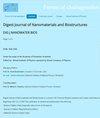热处理对磷灰石生物陶瓷材料结构、形态和化学性质的影响
IF 1
4区 材料科学
Q4 MATERIALS SCIENCE, MULTIDISCIPLINARY
Digest Journal of Nanomaterials and Biostructures
Pub Date : 2023-05-01
DOI:10.15251/djnb.2023.182.531
引用次数: 1
摘要
鉴于这种方法的简单性和快速性,通过双重分解监测磷灰石磷酸盐的合成条件似乎非常有用。本工作主要基于在实验室中用双分解法生产磷灰石,合成并研究了HAP和TCP,以证明热处理和合成温度对磷灰石粉末结构的影响。制备的样品在900°C下煅烧,并在1050、1100和1150°C下烧结。利用XRD、FTIR和SEM-EDX研究了合成和烧结温度对该材料结构的影响。本研究证实煅烧对HAP相的稳定性没有影响。因此,对于合成的TCP:β-TCP是最多的相,其持续率高达91%,并且记录到最小的部分转化为二磷酸二钙。FTIR光谱证实了OH和PO43基团带的持久性,这表明样品的HAP和TCP具有碱性磷灰石结构,煅烧导致TCP Ca3(PO4)2结晶。然而,煅烧后的沉淀物含有β焦磷酸钙Ca2P2O7,HA:Ca10(PO4)6(OH)2构成第二相。在1050°C下处理的合成HAP粉末的SEM显微照片显示颗粒形貌致密且浑浊,而在相同温度下处理的TCP显微照片显示粉末的颗粒形貌多孔且光滑,呈不规则球形。总之,热处理提高了生物陶瓷残留物的性能,有可能创造一种新型的可持续和生物友好材料。羟基磷灰石和磷酸三钙以及其他相关的磷酸钙矿物,由于其优异的生物相容性和骨结合性,其结构和组成与人类骨骼中硬组织的矿物相相似,已被广泛用作骨科植入材料。本文章由计算机程序翻译,如有差异,请以英文原文为准。
Effect of thermal treatment on the structural, morphological, and chemical properties of apatite bioceramicsmaterials
Monitoring the synthesis conditions of apatite phosphate by double decomposition seems very useful in view of the simplicity and rapidity of this method. This work is mainly based on production of apatite in the laboratory by the double decomposition method, HAP and TCP were synthesized and studied to demonstrate the influence of thermal treatment and synthesis temperature on the structure of apatite powders. The prepared samples were calcined at 900°C and sintered at 1050, 1100 and 1150°C. The effect of synthesis and sintering temperature on the structure of this material was investigated using XRD, FTIR, and SEM-EDX. This study confirmed that calcination has no effect on the HAP phase stability elaborated. Therefore,for TCP synthesized: β-TCP is the most phase that persists up to, 91% and a minimal partial transformation into Dicalcium Diphosphate is recorded. FTIR spectrum affirms the persistence of OH– and PO43- group bands suggestingthe basic apatite structure for HAP and TCP of the sample, calcination, leads to the crystallization of TCP Ca3(PO4)2. However, the calcined precipitate contains β calcium pyrophosphate Ca2P2O7, and HA:Ca10(PO4)6(OH) 2 constitutes secondary phase. While the calcination of HAP did not affect it. SEM micrograph of synthetic HAP powder treated at 1050°C revealed particle morphology with the dense and cloudy surface while TCP micrograph powder treated at the same temperature shows particle morphology of porous and smoother surfaces and irregular spherical shape. In conclusion thethermal treatments improve the performance of the bioceramic residueand have the potential to create a new type of sustainable and bio-friendly material. Hydroxyapatite and tricalcium phosphate likeotherrelated calcium phosphate minerals, have been used extensively as orthopedic implant material due to their excellent biocompatibility and bone bonding to its structural and composition alsimilarity to that of mineral phase of hard tissue in human bones.
求助全文
通过发布文献求助,成功后即可免费获取论文全文。
去求助
来源期刊

Digest Journal of Nanomaterials and Biostructures
工程技术-材料科学:综合
CiteScore
1.50
自引率
22.20%
发文量
116
审稿时长
4.3 months
期刊介绍:
Under the aegis of the Academy of Romanian Scientists
Edited by: -Virtual Institute of Physics operated by Virtual Company of Physics.
 求助内容:
求助内容: 应助结果提醒方式:
应助结果提醒方式:


